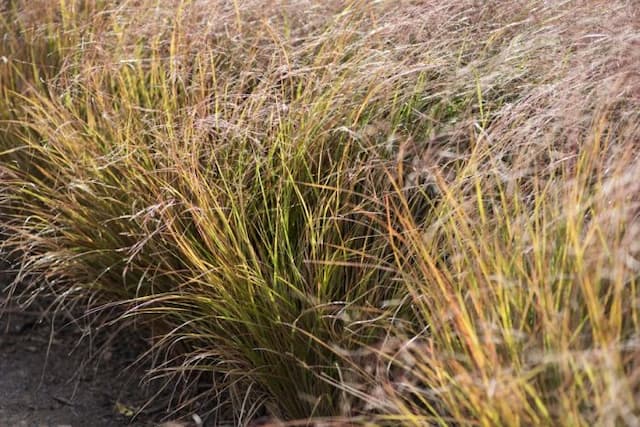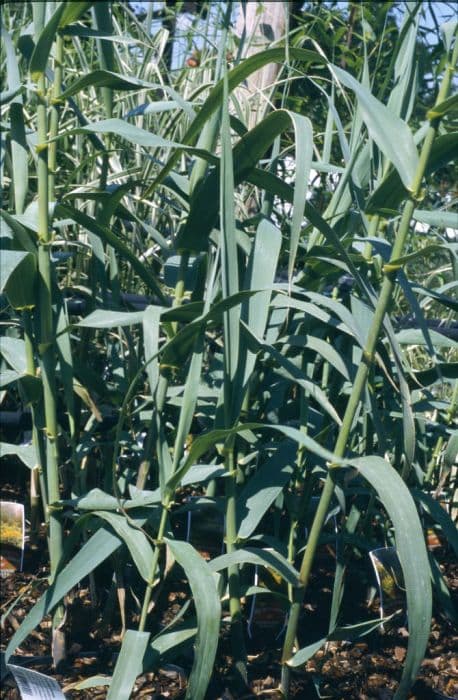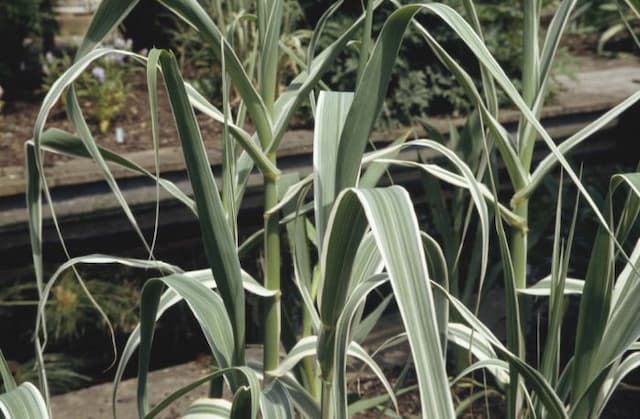Maiden Grass Miscanthus sinensis 'Malepartus'











ABOUT
The Miscanthus sinensis 'Malepartus', commonly known as the Chinese Silver Grass, is a graceful ornamental grass that exhibits a fountain-like form with slender, arching foliage. The leaves boast a vibrant green color and typically have a silver stripe running down the center, giving the appearance of a shimmery silver effect when the plant sways in the breeze. As the seasons progress, the foliage may transform, adopting fiery hues of orange, red, and purple, contributing to a striking autumnal display. Chinese Silver Grass is celebrated for its stunning feathery flower plumes that emerge with a reddish tinge and transition to a silky silver as they mature, often catching the sunlight and adding a soft, glistening touch to the garden. These plumes rise prominently above the foliage and give the plant a fluffy, textured look. The contrast between the fine foliage and the fluffy flower plumes makes it a highly decorative plant that adds movement and interest to any landscape. By winter, the leaves dry to a tan color, and the grass maintains its structure, offering a visual appeal even in dormancy. With its flowing forms and changing colors, Chinese Silver Grass 'Malepartus' provides year-round interest and serves as an elegant focal point or backdrop in garden settings.
About this plant
 Names
NamesFamily
Poaceae
Synonyms
Chinese Silver Grass, Maiden Grass, Eulalia, Zebra Grass, Porcupine Grass
Common names
Miscanthus sinensis 'Malepartus'.
 Toxicity
ToxicityTo humans
Miscanthus sinensis 'Malepartus', commonly known as Maiden Grass, is not known to be toxic to humans. It does not typically cause poisoning if ingested. While the plant is not poisonous, it is not considered edible and ingesting any part of the plant is not advisable. If the sharp edges of the leaves are handled without care, they can cause physical cuts or irritation to the skin.
To pets
Maiden Grass is also not known to be toxic to pets. There are no specific symptoms of poisoning associated with this plant because it is not considered poisonous. However, as with humans, it is not an edible plant, and ingestion of plant material by pets should still be avoided to prevent any potential gastrointestinal discomfort or blockages from the plant's fibrous material. Always monitor pets around ornamental grasses to prevent accidental ingestion.
 Characteristics
CharacteristicsLife cycle
Perennials
Foliage type
Deciduous
Color of leaves
Green
Flower color
Pink
Height
5-7 feet (1.5-2.1 meters)
Spread
3-4 feet (0.9-1.2 meters)
Plant type
Grass
Hardiness zones
5-9
Native area
Asia
Benefits
 General Benefits
General Benefits- Ornamental Appeal: Adds an aesthetic dimension to gardens with its graceful, arching foliage and feathery plumes.
- Drought Tolerant: Once established, it requires minimal watering, making it an ideal choice for drier climates and water-wise gardens.
- Seasonal Interest: Provides visual interest across seasons with foliage that changes color in the fall and flower plumes that persist into winter.
- Low Maintenance: Requires very little care once established, reducing the need for regular gardening activities.
- Habitat Support: Offers shelter and food to wildlife, including birds that may feed on its seeds in the winter.
- Erosion Control: Its robust root system helps stabilize the soil, preventing erosion on slopes and banks.
- Privacy Screen: When planted in groups, it forms an effective visual barrier or privacy screen for yards and outdoor living spaces.
- Hardy and Adaptable: Adaptable to a wide range of soil types, from clay to sandy soils, and tolerant of urban pollution.
- Non-Invasive: Unlike some other tall grasses, 'Malepartus' is not known to be invasive, making it a responsible choice for gardens and landscaping.
 Medical Properties
Medical PropertiesThis plant is not used for medical purposes.
 Air-purifying Qualities
Air-purifying QualitiesThis plant is not specifically known for air purifying qualities.
 Other Uses
Other Uses- Miscanthus sinensis 'Malepartus', often known as Maiden Grass, can be used in basketry due to its pliable stems that can be woven into various shapes and patterns.
- Maiden Grass can serve as a natural musical instrument material, where the dried stems can be used to make flutes or panpipes.
- The dry foliage and stems of Maiden Grass are excellent for creating decorative indoor arrangements or wreaths, adding a rustic touch to home decor.
- It can be utilized as a biofuel crop; due to its high biomass yield, it's considered a sustainable source of energy when processed into bioethanol or burned directly for heat.
- In papermaking, the fibrous nature of Maiden Grass allows it to be incorporated into the pulp, resulting in paper with interesting textures and patterns.
- This grass is also used as a natural dye source; the different parts of the plant can produce subtle natural colors that are used to dye fabrics and yarns.
- As a privacy screen or living fence, Maiden Grass can be densely planted to create physical barriers that are both functional and aesthetically pleasing.
- It can be used in soundproofing applications; dried grasses can be bundled and used as a natural sound barrier for homes in noisy areas.
- Maiden Grass can play a role in bioremediation, where it is planted in areas to help remove contaminants from the soil, although its efficacy may vary depending on the contaminants present.
- Maiden Grass's strong roots are effective for erosion control, helping to stabilize soil on slopes and in areas prone to soil erosion.
Interesting Facts
 Feng Shui
Feng ShuiThe Maidenhair Grass is not used in Feng Shui practice.
 Zodiac Sign Compitability
Zodiac Sign CompitabilityThe Maidenhair Grass is not used in astrology practice.
 Plant Symbolism
Plant Symbolism- Adaptability: Miscanthus sinensis 'Malepartus', commonly known as Maiden Grass, is highly adaptable to various climates and conditions, symbolizing the ability to thrive in diverse environments.
- Resilience: This plant can withstand challenging weather and is known for its resilience, representing the strength to recover from tough circumstances.
- Privacy: The dense growth habit of Maiden Grass can provide privacy in gardens, symbolizing the value of personal space and boundaries.
- Growth and Change: Maiden Grass experiences noticeable changes through seasons, which can symbolize the inevitable growth and transformation in life.
- Beauty and Grace: With its elegant foliage and feathery flowers, Maiden Grass is often associated with beauty and grace, reflecting an appreciation for the aesthetic and the delicate balance of nature.
 Water
WaterMaiden grass requires regular watering, especially during its first growing season to establish a deep, extensive root system. It's best to water deeply but infrequently, providing about 1 inch of water per week, either from rainfall or supplemental watering. This could translate to roughly 0.5 gallons per square foot per week in the absence of rain. In the summer, especially in hotter regions, you may need to water twice a week, while in cooler climates or during the fall, watering can be reduced as the plant requires less moisture. It's important to avoid overwatering, as maiden grass prefers well-drained soil and can be prone to root rot in overly saturated conditions.
 Light
LightMaiden grass thrives in full sun, meaning it requires at least 6 hours of direct, unfiltered sunlight each day to grow and flourish. The ideal spot for maiden grass would be an area that is open to the sky, free from significant shade from buildings, trees, or other structures throughout the day. It can tolerate some light shade, but too much shade will result in less vigorous growth and fewer blooms.
 Temperature
TemperatureMaiden grass is adaptable to a wide range of temperatures and can survive in conditions ranging from -20 to 100 degrees Fahrenheit. The ideal growing temperature for this plant is between 50 and 90 degrees Fahrenheit. Cold-hardy and heat-tolerant, it can endure winter colds as well as the high temperatures of summer, making it suitable for a variety of climates.
 Pruning
PruningPrune maiden grass during late winter or early spring before the new growth starts. This annual pruning helps to maintain an attractive shape and revitalize the plant, encouraging vigorous growth for the coming season. Cut the grass back to about 4-6 inches above ground level. The best time for pruning is just before the last expected frost date in your area, as leaving the dried foliage can provide winter interest and some cold protection.
 Cleaning
CleaningAs needed
 Soil
SoilMaiden Grass thrives in well-draining soil with good fertility and a pH between 5.5 and 7.5. A mix of garden soil, compost, and perlite or sand can create an ideal growing medium for robust growth.
 Repotting
RepottingMaiden Grass, being a large perennial, does not need frequent repotting and typically thrives when planted directly in the ground. It may only need division every few years to maintain vigor.
 Humidity & Misting
Humidity & MistingMaiden Grass is adaptable to a range of humidity levels and does not require any specific humidity conditions for optimal growth, making it suitable for diverse climates.
 Suitable locations
Suitable locationsIndoor
Provide bright light, well-draining soil, but it's better suited outdoors.
Outdoor
Plant in full sun, well-draining soil, and water regularly.
Hardiness zone
5-9 USDA
 Life cycle
Life cycleMiscanthus sinensis 'Malepartus', commonly known as Chinese Silver Grass, begins its life cycle as a seed that germinates in spring, provided there's enough warmth and moisture. After germination, the seedling grows rapidly, developing into a dense clump of foliage with upright stems and arching leaves. Throughout the summer, the plant focuses on vegetative growth, storing energy in its rhizomes. In late summer to early autumn, it reaches a mature phase where it produces tall, feathery flower plumes that can add visual interest to the landscape and can persist into winter. After flowering, seed dispersal occurs, although this cultivar is often less viable in seed production compared to the species. Lastly, in winter, the above-ground foliage dies back, but the plant overwinters through its hardy rhizomes, ready to regrow the following spring.
 Propogation
PropogationPropogation time
Spring-Early Summer
The most popular method of propagation for Miscanthus sinensis 'Malepartus', commonly known as the Chinese Silver Grass, is through division. This process is usually carried out in the spring as the plant emerges from dormancy. To propagate, you would first carefully dig up the established clump, making sure to get a good portion of the root system. Using a sharp spade or knife, you would then divide the clump into smaller sections, each with several growth points or shoots and a healthy amount of roots. Replant the divisions at the same depth they were growing at previously, and water them well to help establish the new plants. This method allows for quick establishment and has a high success rate, making it a preferred choice for gardeners looking to expand their collection of this ornamental grass.









